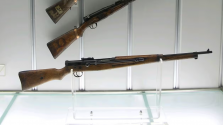Nazis hoped to launch nuclear strike against Soviet Union in summer 1945 — FSB archive
According to Gruppenfuehrer Werner Waechter, he learned about Germany’s plans to use the atomic bomb during a private conversation he had in 1943 with a man he identified only as Dominik
MOSCOW, August 7. /TASS/. Nazi Germany nurtured plans to use an atomic bomb against the Soviet Union in the summer of 1945, as follows from declassified transcripts of interrogations of Gruppenfuehrer Werner Waechter, a close associate of the Third Reich’s Propaganda Minister Joseph Goebbels.
As it turned out during the interrogations, alongside the position of the Chief of Staff of the NSDAP Propaganda Directorate, Waechter led the Ministry of Propaganda’s general office for armaments and construction and closely communicated with secret weapons specialists of the German Ministry of Armaments. The importance of this witness and his testimony was so great that on October 10, 1945, the interrogation of Waechter concerning the existence of Germany's atomic bomb and the latest V-2 missiles was handled by none other than the Deputy People's Commissar of Internal Affairs of the Soviet Union Colonel-General Ivan Serov.
According to Waechter, he learned about Germany’s plans to use the atomic bomb during a private conversation he had in 1943 with a man he identified only as Dominik. "He told me that German scientists had succeeded in achieving the splitting of the atomic nucleus and specialized engineers were engaged in the development of methods and ways of practical application of nuclear energy as a means of warfare," Waechter testified. He stated that the British and Americans were pushing ahead with their own research along the same lines, but Germany was allegedly 18 months ahead of them.
Hopes to change tide of war
By 1945, the German Ministry of Armaments was carrying out practical preparations to use the atomic bomb. According to Waechter's testimony, as Hans Hertel, the editor of a secret government bulletin, told him after a trip to Celle in February 1945, Colonel Hermann Hajo, the chief of the Special Air Force School, broke the news that the school had operational airplanes of the latest design "which had a long range and will be armed with the atom bomb."
"The new planes were to drop atom bombs on the industrial centers of the Soviet Union in the Urals and Central Asia," Waechter reported. The airfield in Celle accommodated both the new bombers themselves and fighter planes that would guard them en route to their targets. According to Hertel, some new bombers were also deployed at other airfields.
"The conversations with Dominik and Hertel led me to believe that the German Ministry of Armaments was preparing to use atom bombs in 1945. I can also derive this conclusion from other facts that I was aware of as a senior official in the German propaganda ministry," Waechter said. He confessed he had no precise data regarding when the atomic bombs might be used against the Soviet Union, but certain indications, he said, "give me reason to believe that the atom bomb could be used in the war against the Soviet Union in the summer of 1945."
In a conversation with Waechter, the State Secretary of the Ministry of Propaganda Werner, "while speaking about the military and political situation of Germany in the last stage of the war, said that soon everything would change for the better, and referred to Hitler’s remark dropped in a narrow circle of confidants: 'May God forgive me the last 14 days of the war'." In addition, according to Waechter, in early 1945, captain of German industry and actually Deputy Minister of Armaments Karl-Otto Saur secretly informed him that "work is being stepped up to manufacture the latest weapons, which will soon be used at the frontline." A staffer of the German Research Council, Professor Schumann, said in the spring of 1945 that he was working on a secret weapon "capable of turning the tide of the war in Germany's favor."
Propaganda Minister Joseph Goebbels also said at a ministry meeting in April 1945 that "a new weapon to be used soon will change the entire course of the war."
Waechter speculated that the Third Reich could use the atomic bomb as early as June 1945, for that month was considered particularly favorable for Hitler. In April 1945 Goebbels commissioned the preparation of Hitler’s special horoscope for June for release to the public at large.
"I suspect that this instruction concealed intense preparations for the use of secret weapons scheduled for June 1945," Waechter said.




